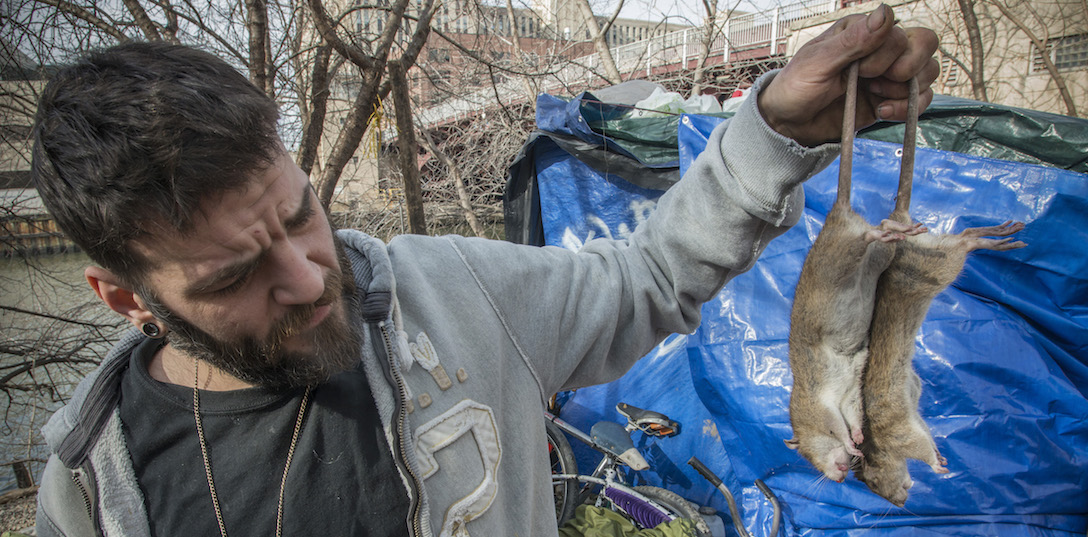By Janice Cantieri / Photography by Lloyd DeGrane
Jimmie Korosa awakened in the middle of the night with a foot-long rat clawing at his back.
Korosa battles the rats every day. Like many people experiencing homelessness in Chicago, he camps in a tent in a vacant lot and faces constant exposure to the disease-carrying rodents.
“When they run by, they sound like a herd of elephants. They’re not afraid of humans – they eat anything and everything,” Korosa said.
More than 30,000 rodent complaints were filed in 2016 alone, according to the City of Chicago’s data portal. But while Chicago’s rats affect the entire city, the homeless are on the front lines.

“I wake up, jump, and then they run out of the tent, but they just come right back. Their teeth look like rows and rows of razor blades,” said Korosa, who lives in an encampment along the Chicago River.
“Before I go to bed, I empty everything out of my tent, so all that’s left in my tent is my blankets and a pillow,” Korosa said. “If there is anything in my tent, they will go in there and hide. Even if I chase them out, they come right back.”
Korosa decided to do something about the problem himself: he started fighting back.
“Every night I come home, empty my tent and I set traps. Within two minutes of setting the traps, they’re both full. I catch about 10 each night, and I throw them in the river,” he said.
Korosa uses gloves to set his two rat traps and throw the dead rats into the river, but he relies on the same, dirty pair of utility gloves since he doesn’t have access to disposable gloves, he said.

Living in close proximity to rats can increase the risk of contracting one of many infectious diseases, according to the Centers for Disease Control and Prevention.
In Chicago, the primary rodent-borne diseases are rat-bite fever, leptospirosis, and lymphocytic choriomeningitis, but reported cases are rare, said Dr. David Schwartz, chair of infectious diseases at Cook County Health & Hospitals. Leptospirosis is a bacterial infection that causes aseptic meningitis (the swelling of membranes surrounding the brain), and, occasionally, kidney and liver failure, he said.
“We see patients with leptospirosis, which has also been described in other U.S. cities, slightly more often [than other rodent-borne diseases], once every year or two, and virtually always among persons with presumed exposure to rat urine from unsafe housing or work,” Schwartz said.
But, despite the health risks, the homeless have become experts in rodent control—not by choice but out of necessity. Donald King and Charles Holder, residents of an encampment beneath Lake Shore Drive, say they have killed 35 rats this year alone.

“We’ve got rat traps and poison, but mainly we kill them by hand. We grab them and get a rock, shovel, brick or stone and kill them,” Holder said.
Holder pointed out several trails leading to holes in the bottom of tree trunks, which he called “rat trails.” The rats run down from the holes straight to the viaducts in packs, he said.
“If the trail is coming towards you, they’ll come right to your tent at night,” he said. Pointing to one burrow, he said, “At night, there’s about 20 or 25 rats coming out of that hole.”

Holder’s neighbor Donald King filled a burrow with lighter fluid to burn the rats out because they were coming into his tent and running through the viaduct every night, he said.
“I killed more rats this winter than anyone, because they were out here every night and no one was doing anything about it. I put lighter fluid in the holes where they burrow and lit that up. They all went running,” King said.
The City of Chicago has taken action to reduce the population of rats by adding additional teams to its Rodent Task Force, said Jennifer Martinez of the Department of Streets and Sanitation.
“We really try to identify the food source and eliminate that. We have teams that come out, and we just added 10 more teams to our Rodent Task Force.” Martinez said. “As of this year, we must respond to all calls within a week.”
Additionally, a new program has been implemented in several downtown locations to spray dry ice into rat burrows. The burrows are then covered, and as the ice melts, it turns into carbon dioxide and suffocates the animals, she said.

“We’re excited for the dry ice. We just started the dry ice program in late August in mostly downtown locations to start. So far it’s been effective, with a 60 percent reduction in holes,” Martinez said.
As for the city’s homeless, Martinez said that teams from the department visit communities and provide tips on how to avoid rat infestations. She recommended that those affected, including the homeless, call 3-1-1 to file complaints.


